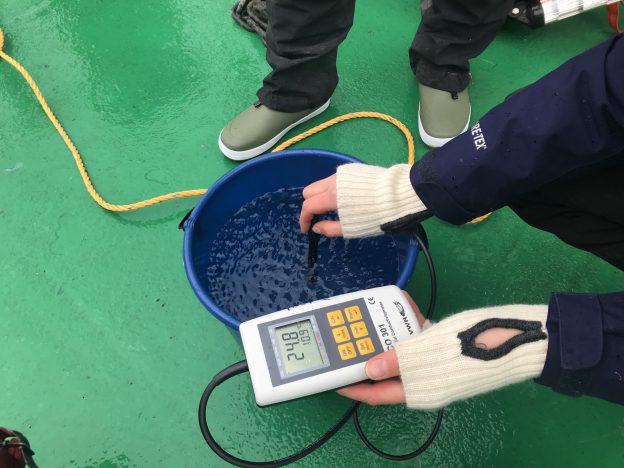Kjersti, Steffi, Elin and myself (Mirjam) recently discussed ways to better integrate the GEOF105 student cruise into the course. Right now, even though students write a report about their work on the student cruise, it’s pretty much a one-off event with little connection to what happens before and after, which is a pity. Having a whole research ship for a whole day for a group of 6-8 students (or possibly 10 next year) is such an amazing opportunity! We want to help students make the most of it by attempting to foster a curious mindset before they board the ship.
One idea is to ask the students to observe things throughout the whole duration of the semester, and then have them relate their own “time series” of those observations with what they observe on the student cruise. Ideally, students will be observing their chosen topic for a couple of weeks before the cruise, then go on the cruise looking at everything there with a focus on that topic, and then continue to observe it in their daily lives after the cruise. But even if it’s not connected to the student cruise or this specific class, I think giving students the task to make regular observations over the course of a whole semester would be a really good way to connect their studies better with their regular lives outside of university.
Do I have ideas of what the topics could be? Of course! And I have scheduled posts over the next two months, in which my ideas will be presented one by one. But today, I want to talk about what I think what purpose this assignment would serve.
The goal is not to collect data that will advance science or to work on original research questions. It is rather to help students get into the practice of focussing on details in the world around them that might otherwise go unnoticed. To collect observations using only minimal resources (like for example stopping on their commute for seconds only, taking pictures with their smartphones, using the readily available weather forecast for context). To try and explain pattern they observe using their theoretical background from university. I want to help students get into the habit of actively observing what is going on around them, to become fascinated with discovering things related to their studies in their everyday lives.
I myself, for example, am absolutely fascinated with waves, and I notice them anywhere (read more about that on my blog, if you are interested). On the most recent GEOF105 student cruise, there was a bucket that was used to bring seawater up on the deck for salinity to be measured. And what jumped out on me? The standing waves in that bucket! You see them in the picture below, but what struck me was that most people really didn’t seem to notice what was going on there, and how FASCINATING it was. Someone even commented to the effect that they would have never noticed the waves in the bucket if I hadn’t pointed them out to them, even though they were sticking probes right into the waves. And while I spent the better part of two days moving the bucket around to see all the different wave pattern that occurred on different spots on deck, most other people didn’t even seem curious to find out why myself and a handful of other people were staring into a blue plastic bucket. And that makes me sad. Does everybody need to find waves fascinating? Of course not. But should students at least be a little curious about science topics that clearly fascinate their instructors? Yes, I believe so.

So my mission with this series of blog posts is to give examples of where you can easily observe oceanography-related phenomena in and around Bergen, hoping that you might start looking at those spots with different eyes. And maybe you will find a specific topic that you become fascinated with. Because once you start focussing on something that seems random and rare, the very thing seems to appear everywhere in your daily life. Like for example hydraulic jumps. As shown in the picture below — once you start focussing on those, you see them appear everywhere as if out of thin air.

This kind of curiosity around physics phenomena is — in my opinion — absolutely desirable, especially in students. It makes dry theory or seemingly obscure topics become more relevant. As you start noticing phenomena, you also start noticing more about them, for example understanding the conditions under which the appear. And you also start anticipating where they might occur, so you will look to see whether your prediction is correct. It’s a vicious circle, but one that I would encourage you — and especially students — to enter. To me, it’s part of my identity as a scientist — to use my initial understanding of processes to continuously want to learn more and more about them.
Wave watching has definitely become a part of my life that I don’t want to miss. What will you start seeing everywhere? Or what is it that you are maybe already seeing everywhere that most people don’t? I am anticipating that my suggestions in this #BergenWaveWatching series will be strongly biased towards #wavewatching, so if you have any other suggestions (maybe even with pictures already?), I would love to hear about them! 🙂
